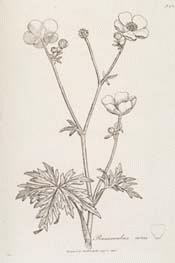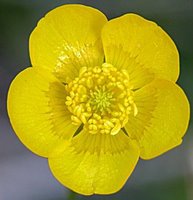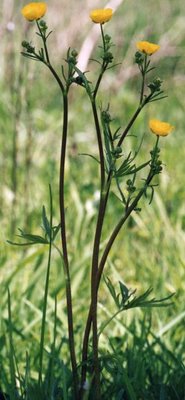Ranunculus acris (crowfoot)

Ranunculus acris (crowfoot)
Synonyms
Gold Cup. Grenouillette.

Habitat
This Buttercup is a native of meadows and pastures in all the northern parts of Europe, and is very common in England, flowering in June and July.
The leaves vary a good deal in form, according to their position on the plant: the lower leaves are on long petioles (foot-stalks) and are comprised of numerous wide-spreading and deeply divided segments; the upper leaves are small, composed of few segments, simple in form and few in number. The root is perennial, though the plant itself dies down each autumn, and has many long, white fibres.
The petals of the flower are bright, shining yellow; the calyx is composed of five greenish-yellow spreading sepals. The centre of the flower, as in other Buttercups, is a clustering mass of stamens round the smooth, green immature seed-vessels, which develop into a round head of numerous small bodies called achenes.
Most of the Crowfoots are known to be acrid and some even to be poisonous, but this plant receives its Latin specific name of acris from its supposed intensity of acridity, for all parts of it are intensely acrid. It has been stated that even pulling it up and carrying it some little distance, has produced considerable inflammation in the palm of the hand, and that cattle will not readily eat it in the green state, and if driven by hunger to feed on it, their mouths become sore and blistered. According to Linnaeus, sheep and goats eat it, but cattle, horses and pigs refuse it. When made into hay, it loses its acrid quality, but then seems to be too hard and and stalky to yield much nourishment. The notion that the butter owes its yellow colour to the prevalence of buttercups in the meadows, is quite groundless - it is the richness of the pasture that communicates this colour to the butter and not these flowers which the cattle seldom or never touch willingly.
- Miss Pratt (Familiar Wild Flowers) states:
- 'Instances are common in which the wanderer in the meadow has lain down to sleep with a handful of these flowers beside him, and has awakened to find the skin of his cheek pained and irritated to a high degree, by the acrid blossoms having lain near it.'
- Old authors say:
- 'this fiery and hot-spirited herb is not fit to be given inwardly, but that an ointment of the leaves and flowers will raise a blister and may be applied to the nape of the neck to draw rheum from the eyes,' and that mixed with a little mustard it raises a blister as perfectly as the Spanish Fly.
Part Used
Whole herb.
The fresh leaves formed part of a famous cure for cancer, practised by a Mr. Plunkett in 1794.
Thornton, in his Herbal of 100 years ago, says if a decoction of the plant be poured on ground containing worms, 'they will be forced to rise from their concealment.'


0 Comments:
Post a Comment
<< Home